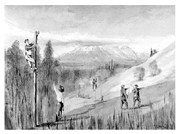No edit summary |
No edit summary |
||
| Line 46: | Line 46: | ||
Founded in 1864 as the Russian-American Telegraph Company (also referred to as the Collins Overland Telegraph Company), it was created as a subsidiary of the {{RA|United States|American}} {{W|Western Union}}. The architect of the company, entrepreneur {{W|Perry Collins}}, supported the creation of an {{W|Russian–American Telegraph|overland telegraph connection}} spanning across the {{RA|Russian Empire}}. At the time, attempts to establish a {{W|transatlantic telegraph cable}} were unsuccessful. After experiencing the rapid growth of telegraph lines across Russia, Collins believed that an overland line across {{W|Siberia}} and {{RA|Russian America}}, combined with an {{W|Submarine communications cable|undersea cable}} spanning across the shallow and shorter {{W|Bering Sea}}, would prove successful in connecting {{W|Europe}} with {{W|North America}}. |
Founded in 1864 as the Russian-American Telegraph Company (also referred to as the Collins Overland Telegraph Company), it was created as a subsidiary of the {{RA|United States|American}} {{W|Western Union}}. The architect of the company, entrepreneur {{W|Perry Collins}}, supported the creation of an {{W|Russian–American Telegraph|overland telegraph connection}} spanning across the {{RA|Russian Empire}}. At the time, attempts to establish a {{W|transatlantic telegraph cable}} were unsuccessful. After experiencing the rapid growth of telegraph lines across Russia, Collins believed that an overland line across {{W|Siberia}} and {{RA|Russian America}}, combined with an {{W|Submarine communications cable|undersea cable}} spanning across the shallow and shorter {{W|Bering Sea}}, would prove successful in connecting {{W|Europe}} with {{W|North America}}. |
||
| + | |||
| + | [[File:Collins Overland Telegraph.gif|thumb|left|''Painting of men working on the Collins Overland Telegraph line'', by John Clayton White.]] |
||
After receiving support from the {{RA|Russian Empire}}, the {{RA|United Kingdom}}, and the {{RA|United States}}; preparations began the following year. Despite hopes of becoming the first telegraph connection between {{W|Europe}} with {{W|North America}}, a successful {{W|transatlantic telegraph cable}} was established in 1866. Due to the investments already made and hopes to further connect the two halves of the empire together, the project would continue. It is also believed that the construction of the telegraph line precipitated the {{RA|Columbia Sale}} in 1867. |
After receiving support from the {{RA|Russian Empire}}, the {{RA|United Kingdom}}, and the {{RA|United States}}; preparations began the following year. Despite hopes of becoming the first telegraph connection between {{W|Europe}} with {{W|North America}}, a successful {{W|transatlantic telegraph cable}} was established in 1866. Due to the investments already made and hopes to further connect the two halves of the empire together, the project would continue. It is also believed that the construction of the telegraph line precipitated the {{RA|Columbia Sale}} in 1867. |
||
Revision as of 01:08, 12 October 2021
| The following Russian America page is under construction.
Please do not edit or alter this article in any way while this template is active. All unauthorized edits may be reverted on the admin's discretion. Propose any changes to the talk page. |
 | |
| Native name | АО «СТиТ» |
|---|---|
| Romanized name | AO "STiT" |
| Type | Joint-stock company |
| Industry | Telecommunications Technology Mass media |
| Founded | 1864 |
| Founder(s) | Perry Collins |
| Headquarters | Alaska |
| Area served | Worldwide |
| Key People | David Sarnov Semyon Ayzenshteyn Yakov Ayvaz Vasily Dubilyer |
| Website | stit.com |
JSC STiT (Russian: АО «СТиТ», AO "STiT") is an Alaskan multinational telecommunications and technology company.
History
Founded in 1864 as the Russian-American Telegraph Company (also referred to as the Collins Overland Telegraph Company), it was created as a subsidiary of the American Western Union. The architect of the company, entrepreneur Perry Collins, supported the creation of an overland telegraph connection spanning across the Russian Empire. At the time, attempts to establish a transatlantic telegraph cable were unsuccessful. After experiencing the rapid growth of telegraph lines across Russia, Collins believed that an overland line across Siberia and Russian America, combined with an undersea cable spanning across the shallow and shorter Bering Sea, would prove successful in connecting Europe with North America.

Painting of men working on the Collins Overland Telegraph line, by John Clayton White.
After receiving support from the Russian Empire, the United Kingdom, and the United States; preparations began the following year. Despite hopes of becoming the first telegraph connection between Europe with North America, a successful transatlantic telegraph cable was established in 1866. Due to the investments already made and hopes to further connect the two halves of the empire together, the project would continue. It is also believed that the construction of the telegraph line precipitated the Columbia Sale in 1867.
The telegraph line was fully completed in the 1870s, at which point the purpose of the company was tasked with operating and maintaining the system. Aside from a few expansion projects within Russian America and across Siberia, the company remained focused on telegraphy. This would change in 1909 when American Telephone and Telegraph (AT&T) gained a controlling share of Western Union. As a subsidiary of AT&T, the Russian-American Telegraph Company would expand into early telephony. Also during this time, Semyon Ayzenshteyn and the Russian Society of Wireless Telegraphs and Telephones (ROBTiT) would cooperate to bring about wireless telegraphy and early radio into the company. In 1913, AT&T was forced to sell off Western Union due to antitrust laws. As a consequence, both the American Krai and the Russian Empire forced the sale of the RATC and reorganized it into the independent Overland Telegraph and Telephone Company (Russian: Сухопутный Телеграф и Телефон, Sukhoputny Telegraf i Telefon) (СТиТ, STiT).
